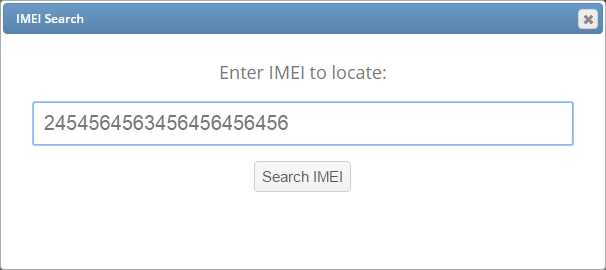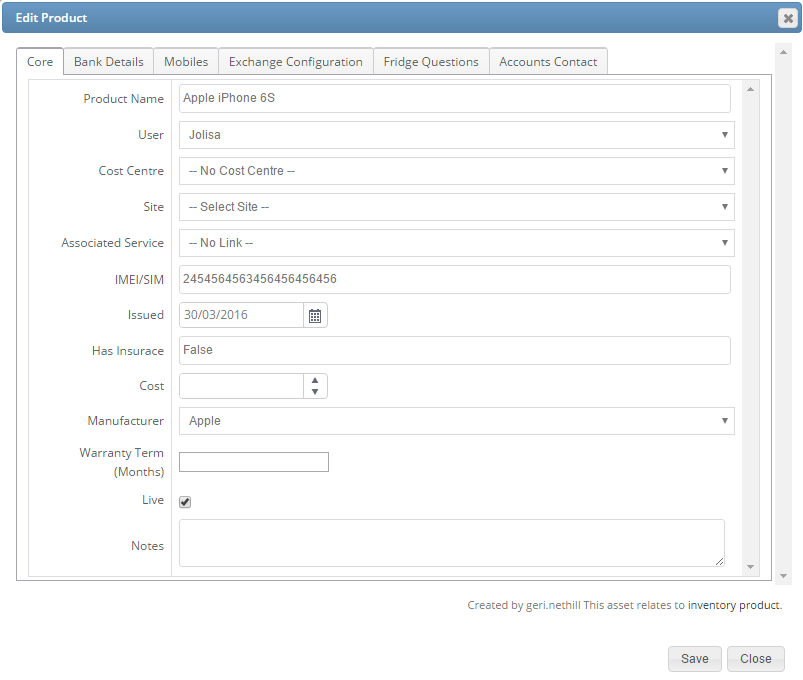In the Layer it is possible to search for a product serial number or an International Mobile Equipment Identity (IMEI) number quickly and efficiently as long as the number has been stored in the Layer.
Please note that in order to search for the serial number you must ensure all IMEI's are logged where possible in the Layer. This includes:
- Sales Order Data Capture
- Stock
- Assets
- Incoming delivery movement sessions
The ability to search for an IMEI includes benefits such as:
- Fast Customer Service: Locate an item quickly if you have the IMEI number
- Prevent Fraud: In instances where equipment has been lost or stolen, if you have the serial number you can arrange for a mobile phone to be blocked quickly or the hardware to be added to the police stolen items register.
- Prevent False Claims: Quickly confirm if an item actually originated from your company to ensure you only carry out repairs for the correct handsets.
- Warranty Quickly establish if there is any remaining supplier warranty on the hardware supplied.
- Track Stock: Quickly check the status of an IMEI number with your catalogue of stock and track any stock movements that are relevant to the IMEI
Prerequisites: In order to search by an IMEI users must have the following permissions:
- Search All: Users in this group can search everything and have access to advanced search. N.B. users must have this permission in order to search via the IMEI search function that we will discuss below.
- Search Customer Products via Serial: Users with this permission will be able to search for customer products.
Searching for an IMEI via the IMEI Search Window (Hamburger symbol)
1. Log into the Layer
2. From the global search field select the hamburger symbol
3. From the drop down list select IMEI Search

4. The IMEI Search window will be displayed
5. Simply type in your serial number or scan the serial number into this field

6. Press 
7. All applicable search results will now be displayed within the Property Search Results, users will note that the following search results are displayed:
Created: The date that the record type was created
Record Type: The record type which will display the following results if they are available:
- Sales Order Data Capture: When the IMEI was logged in Data Capture at the point of sales order following the stock allocation
- Stock Movement Out: When the IMEI was booked out to a customer
- Sales Order Delivery: When the IMEI was shipped out
- Stock: When the IMEI was Booked Out
- Stock Movement IN: When the IMEI was booked into the Layer Stock
- Customer Product: The product that the IMEI is logged against e.g. iPhone 6S within the customer record (customer product assets)
Description:
Sales Order: The sales order that this IMEI/Stock item was reserved against followed by the customer name
Name of Product: The product that the IMEI was logged against, e.g. iPhone 6s
Status: The various statuses of the IMEI e.g. New, Shipped, Booked out etc.
Detail: The IMEI number
N.B. Selecting any of the options under the Record Type and Description the Layer will then redirect you towards this record type in the Layer e.g. Stock will take you to the Product stock page that the IMEI is logged against e.g. Apple iPhone 6S (Data Select) whereas clicking on a Sales Order reference will take you to that sales order page.
All of these different fields will allow users to piece together a history of the IMEI number within the Layer i.e. with your company (stock/orders) or a customer record (sold products/assets).
By studying the screen below we can determine that IMEI number 2454564563456456456456 was successfully booked into the Layer and then processed until the point of being a live Asset within the customer record Magic Spark.
All of this information will allow staff to correctly track an asset/IMEI to ensure that your customer service needs are being met.

Searching for an IMEI via the Global Search Field
The previous IMEI search still exists in global search and is maintained to make it easier for users to complete a simple search of customer assets only. Users in a customer service role for example, may only want to search existing customer product assets and not stock, sales orders etc.
To search for an IMEI via the Global Search field users must follow these simple steps:
From the Global Search field enter your IMEI number, users now have two options which are:
- Enter in the IMEI number and wait for the result to populate, selecting the result that populates will direct users towards the customer page:

- Enter the IMEI number in the global search bar and press enter to return the results:

Both methods will direct a user to the same Edit Product page but unlike the Hamburger method we demonstrated above, users will not see an immediate history of the IMEI asset in terms of stock movement history etc. but rather the asset information for that IMEI number will be displayed:

